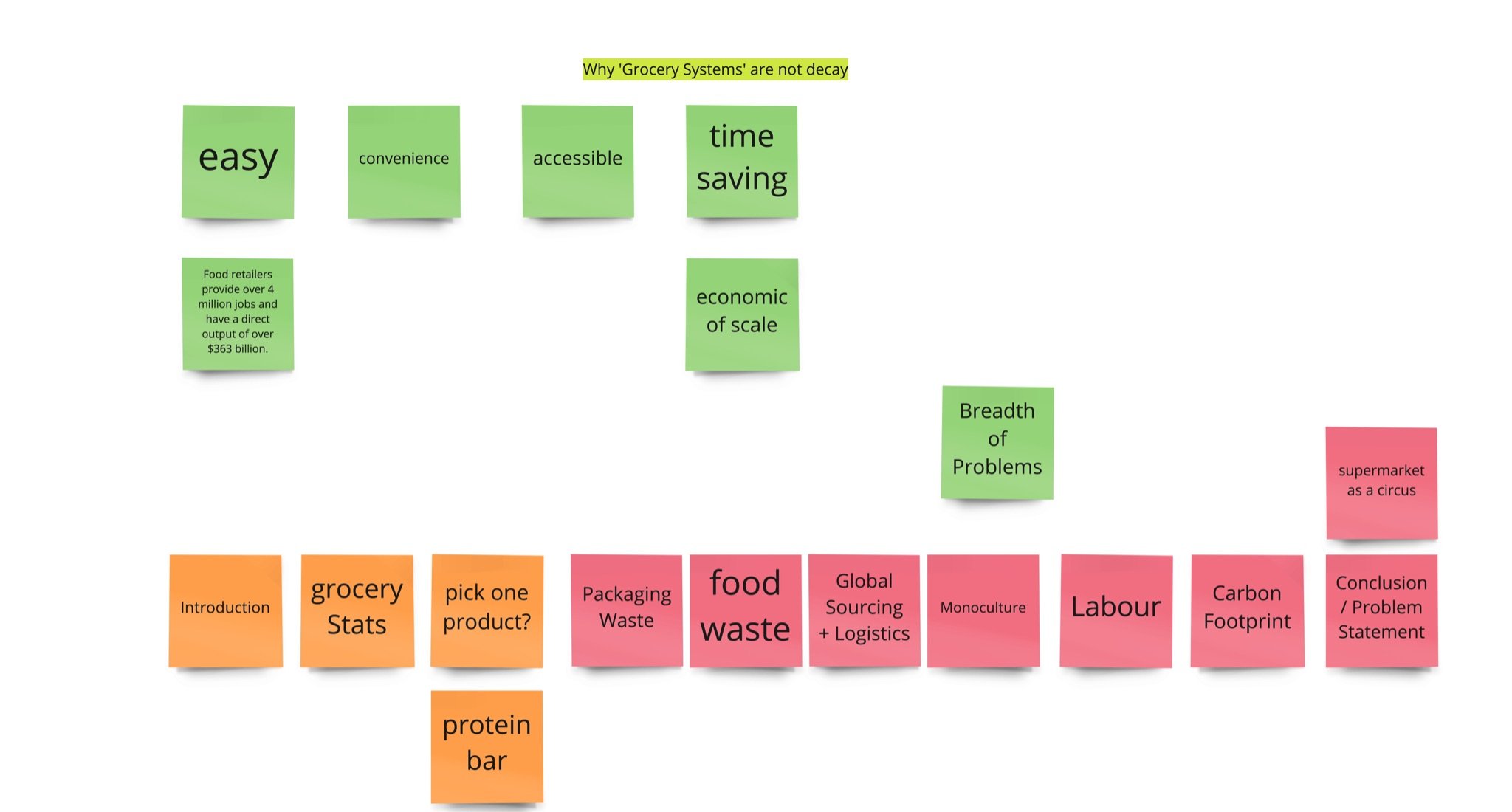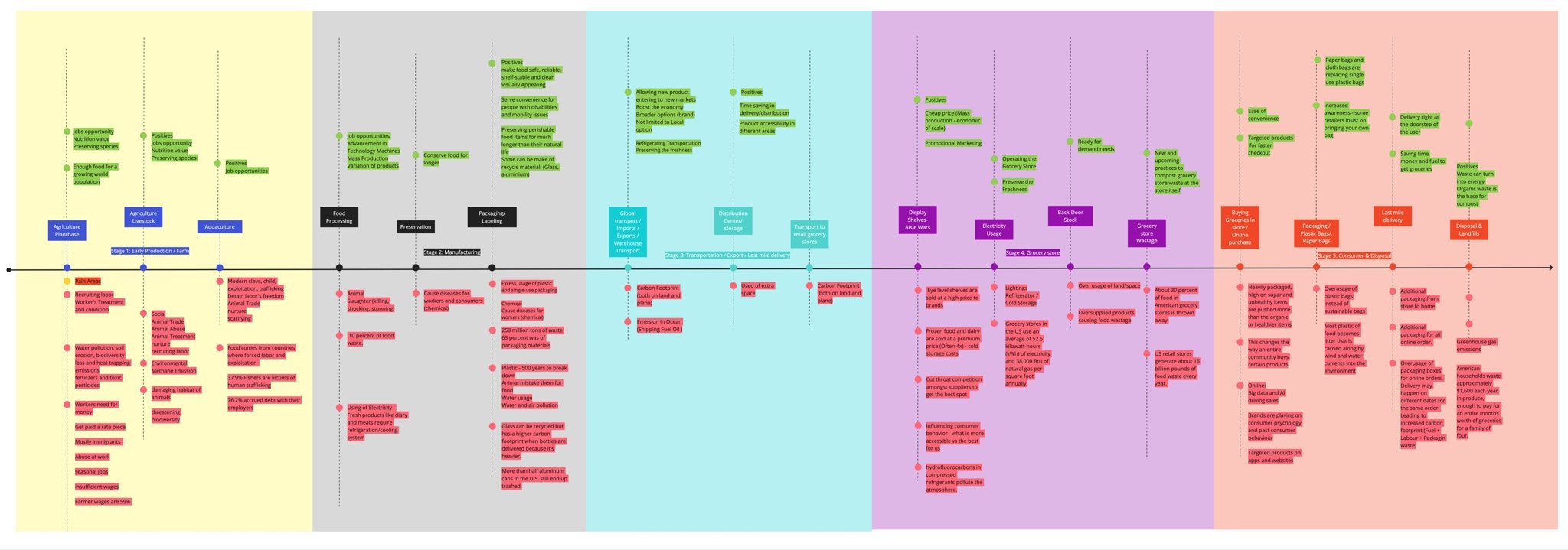Grocery Story
Grocery Store System
Scope
Design thinking, Data Visualization
Team
Dhairya Sathvara
Valentina Palacios
Supanit Loharjun (Pun)
Skills Used
Data and Research ,Data Analysis and Insight, Information Organization, Data Visualization. Sense Making, Graphic Design, Prototyping & Mock-Up Creating, Product Design
Tools
Miro, Collaborative Platform, Adobe Illustration, Adobe InDesign, Adobe Photoshop
Roles
Collaborator
Visual Designer
Overview
This project was a part of Strategic Design and Management in the New Economy. The project is a series of coursework executed under the theme of the grocery system. It breaks down into three parts: background research, information mapping, and 3D design.
Working as a team of four, we found grocery stores to provide convenience, offer various types of items, and give opportunities for communities to grow. At the same time, the grocery store system has several negative long-term consequences for communities and the environment. Whether the grocery system is decaying or growing depends on where you look in this complex world.
01 Background Research
-
Grocery stores are a place that provides convenience and offers various types of items, and gives opportunities for communities to grow. The grocery store system has several negative long-term consequences for both communities and the environment. The Grocery business has already integrated itself with almost everybody's lifestyles, creating a dependency that would be hard to separate. The grocery store system has caused several environmental, ethical, and economic issues from start to end - beginning in the supply chain to the consumers. The root cause started from the customers.
The grocery store system offers various products to serve people's needs, but people are tentatively overbuying. On the business side, it is good because they benefit from this behavior. However, grocery stores have to have all the supplies fully stocked to maintain a happy customer base. It rigs the actual supply and demand needed, resulting in an overflow effect in overproduction. The loss to production includes labor, time, investment, and environmental waste from flaw assumption and education on product. The system leaves a long-term and long-lasting environmental impact from direct and indirect actions within the supply chain: single-use plastic, food waste, carbon emission, landfills, product transportation, etc.
Consequently, ethical issues arise regarding labor from the production resources standpoint, such as unfair treatment, underpay, poor working conditions, child labor, and slave labor. If no action is taken on this matter, the consequences will continue to rise. Thus, the grocery store and its supply chain are decaying.
-
Nowadays, people have become more aware and educated on sustainability, and we are beginning to see the shift to a more sustainable society. The movement, lifestyle, and behavior of people have been changing. With that, society seeks someone to blame for the consequences that have arisen from being unsustainable over all these years, and society has the grocery stores as the target because they are the ones who have power control from beginning to end. The grocery business and the whole food supply chain ecosystem have become the target for society to blame. Which, in hindsight, twisted demand, causing supply to overflow from overproduction which partially has come from customer behavior. The demand for a corporation's reformation from customers has pressured the business to act on it.
Businesses are facing a problem because not all of it is directly created by them. Actuality is driven by the customers, pushing companies to lower their prices and increase their variety to appeal to the growing needs of the end consumer. With this dilemma, companies are trying to find the right balance that can satisfy the end consumer yet still fulfill their obligations and overall still be environmentally and economically sustainable.
Losing the customer is not an option; grocery stores need to adapt quickly to the customer's needs. By doing this, they lean towards a more unsustainable solution that takes a toll on both the corporation and the supply chain ecosystem. The real questions come as to how grocery stores and the supply chain can find the middle ground, where the grocery store can maintain its successful business yet and address unsustainable concerns. Balancing the performance of grocery stores and their supply chain with their service will always be challenging. Still, it has to be done to ensure the sustainability of the system or not, and there could be something new to replace the whole grocery system that consumers might find a better alternative.
02 Information Mapping
Are grocery system decaying or not?
Conducting research, brainstorming ideas, and comprehensive analysis to understand the grocery system and its advantage and disadvantage, then translating into a data visualization.
Mapping
About the map
The map is designed to present different phases of the grocery system, from early production to grocery stores and in customers’ hands, given the trail and track streamline. The bubble text presents positive and negative data and facts about the activities.
How we made the map?
As a team, we seek for a platform where we can work together simultaneously, which Miro, a collaborative platform, allows us to do. The map is composed of graphic elements visualizing the system.
03 Translate into 3D-Design
From ‘Groceries’ to ‘Gross Stories’
Building upon prior projects, translating 2D data mapping into a comprehensive 3D model within the context of the grocery system. Drawing inspiration from the mechanics of Monopoly combined with the grocery system context, where each step from farming to the store shelf is like a move on the game board. This helps us see the journey and the money side of things – how costs go up and down and what benefits or drawbacks can happen at each step. This new way of showing and also helps people learn more about how the grocery system works, making it fun and educational at the same time.
A game where you can win morally or by adopting unethical practices. Choice is yours.
Gross Coins a new age cryptocurrency for managing the supply chain business for transaction.
About the design
The game board employed a blend of images and illustrations reminiscent of the diverse versions of Monopoly while retaining its core structure. In a parallel fashion, elements like the instruction manual cover and currency notes took cues from the layout of a grocery store floor plan. Notably, food grocery items were repurposed as player markers, further weaving the game into the context of the grocery system.













